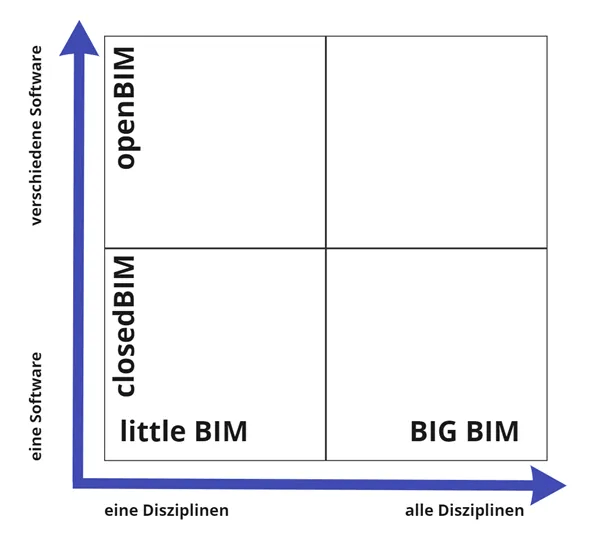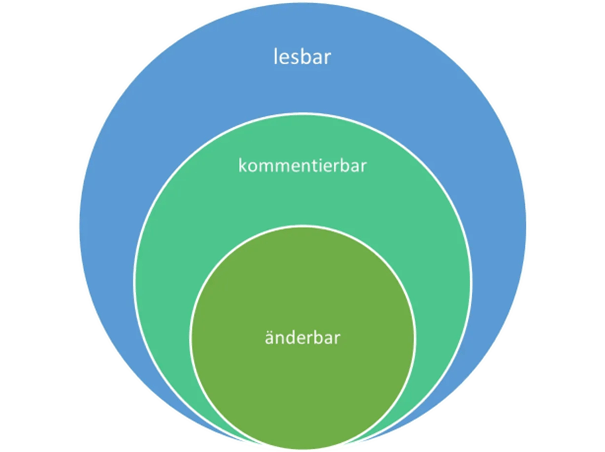1.2 open BIM
Die Vorteile der BIM-Methode sollten nicht nur technisch, sondern auch strukturell voll ausgenutzt werden. Daher ist der Einsatz der openBIM-Methode in allen Projekten empfehlenswert. Hinsichtlich Umsetzung und Zusammenarbeit ergeben sich folgende Vorteile:
- Software-Unabhängigkeit und Wahlfreiheit bei der Applikation aller Projektbeteiligter.
- daher kein Wettbewerbsnachteil aufgrund von Festsetzungen zu Applikationsverwendungen.
- langfristige Verwendbarkeit der Modelldaten (Nachhaltigkeit durch ISO-Zertifizierung von IFC und IDM).
- Autarkie von software-spezifischen Modellinformationen (Transparenz).
Die Entwicklungsstufen von BIM geben dahingehend eine klare Einstufung ab:
- little BIM: BIM-Insel, BIM-Einsatz nur in vereinzelten Disziplinen
- BIG BIM: BIM-Integration in allen Disziplinen
- closedBIM: geschlossene Lösung, Verwendung einer Software(-familie)
- openBIM: offene Lösung, Austauschbarkeit über verschiedene BIM-fähige Software-Produkte

Abbildung: closedBIM vs. openBIM
openBIM
Building Smart Erklärung openBIM (Englisch)
openBIM erweitert die Vorteile von BIM (Building Information Modeling), indem es die Zugänglichkeit, Nutzbarkeit, Verwaltung und Nachhaltigkeit von digitalen Daten in der Bauindustrie verbessert. Im Kern ist openBIM ein kollaborativer Prozess, der herstellerneutral ist. openBIM-Prozesse können als gemeinsam nutzbare Projektinformationen definiert werden, die eine nahtlose Zusammenarbeit für alle Projektbeteiligten unterstützen. openBIM erleichtert die Interoperabilität zum Nutzen von Projekten und Anlagen während ihres gesamten Lebenszyklus.
openBIM befähigt die Beteiligten, neue Arbeitsweisen zu entwickeln, indem es die traditionellen Peer-to-Peer-Arbeitsprozesse transformiert. Durch das Aufbrechen von Datensilos kann openBIM die Projektabwicklung und Anlagenleistung erheblich verbessern. Unternehmen, die einen openBIM-Ansatz verfolgen, entwickeln eine parteiübergreifende Zusammenarbeit, verbesserte Kommunikation und Austauschmethoden nach Industriestandard. Dies führt zu besseren Projektergebnissen, grösserer Vorhersehbarkeit, verbesserter Leistung und erhöhter Sicherheit bei reduziertem Risiko. Während des gesamten Lebenszyklus einer Anlage hilft openBIM dabei, Menschen, Prozesse und Daten miteinander zu verbinden, um die Ziele für die Lieferung, den Betrieb und die Instandhaltung der Anlage zu erreichen. openBIM und nahtlose digitale Workflows machen wichtige Projektinformationen für alle Beteiligten zeitnah zugänglich, um die Entscheidungsfindung in den verschiedenen Phasen des Projekts zu unterstützen - von der Planung über die Übergabe bis hin zur Sanierung und sogar zum Abriss. openBIM beseitigt das traditionelle Problem der BIM-Daten, die typischerweise durch proprietäre Datenformate von Anbietern, durch Disziplinen oder durch die Phase eines Projekts eingeschränkt sind.
Durch die Einhaltung internationaler Standards und Arbeitsabläufe erweitert openBIM die Breite und Tiefe der Nutzung von BIM durch die Schaffung einer gemeinsamen Ausrichtung und Sprache. Technische Anwendungen, die für openBIM entwickelt wurden, verbessern die Verwaltung der Daten und beseitigen unzusammenhängende Arbeitsabläufe. Unabhängige Qualitätsbenchmarks sorgen für einen zuverlässigen offenen Datenaustausch.
openBIM ermöglicht digitale Arbeitsabläufe auf Basis von herstellerneutralen Formaten wie IFC, BCF, etc.
openBIM ermöglicht einen zugänglichen digitalen Zwilling, der die zentrale Grundlage für eine langfristige Datenstrategie für gebaute Anlagen darstellt. Dies sorgt für eine bessere Nachhaltigkeit von Projekten und für ein effizienteres Management der gebauten Umwelt.
Die Prinzipien von openBIM:
- Interoperabilität ist der Schlüssel für die digitale Transformation in der Bauindustrie.
- Offene und neutrale Standards sollten entwickelt werden, um die Interoperabilität zu erleichtern.
- Ein zuverlässiger Datenaustausch hängt von unabhängigen Qualitätsmassstäben ab.
- Zusammenarbeits-Workflows werden durch offene und agile Datenformate verbessert.
- Flexibilität bei der Wahl der Technologie schafft mehr Wert für alle Beteiligten.
- Die Nachhaltigkeit wird durch langfristige, interoperable Datenstandards gesichert.
Die Vorteile für die Bauindustrie sind:
- openBIM verbessert die Zusammenarbeit bei der Projektabwicklung erheblich.
- openBIM ermöglicht ein besseres Asset-Management.
- openBIM ermöglicht den Zugriff auf BIM-Daten, die während der Planung für den gesamten Lebenszyklus des Bauwerks erstellt wurden.
- openBIM erweitert die Breite und Tiefe von BIM-Ergebnissen durch die Schaffung einer gemeinsamen Ausrichtung und Sprache. Sowie durch die Einhaltung internationaler Standards und gemeinsam definierter Arbeitsprozesse.
- openBIM ermöglicht eine gemeinsame Datenumgebung, die den Anwendern Möglichkeiten zur Entwicklung neuer Arbeitsabläufe, Softwareanwendungen und Technologieautomatisierung bietet.
- openBIM ermöglicht einen zugänglichen digitalen Zwilling, der die zentrale Grundlage für eine langfristige Datenstrategie für gebaute Anlagen bildet
openBIM
OpenBIM Daten müssen:
- für alle lesbar sein
- für viele kommentierbar sein
- und für wenige änderbar sein

Abbildung: openBIM Datenhierarchie